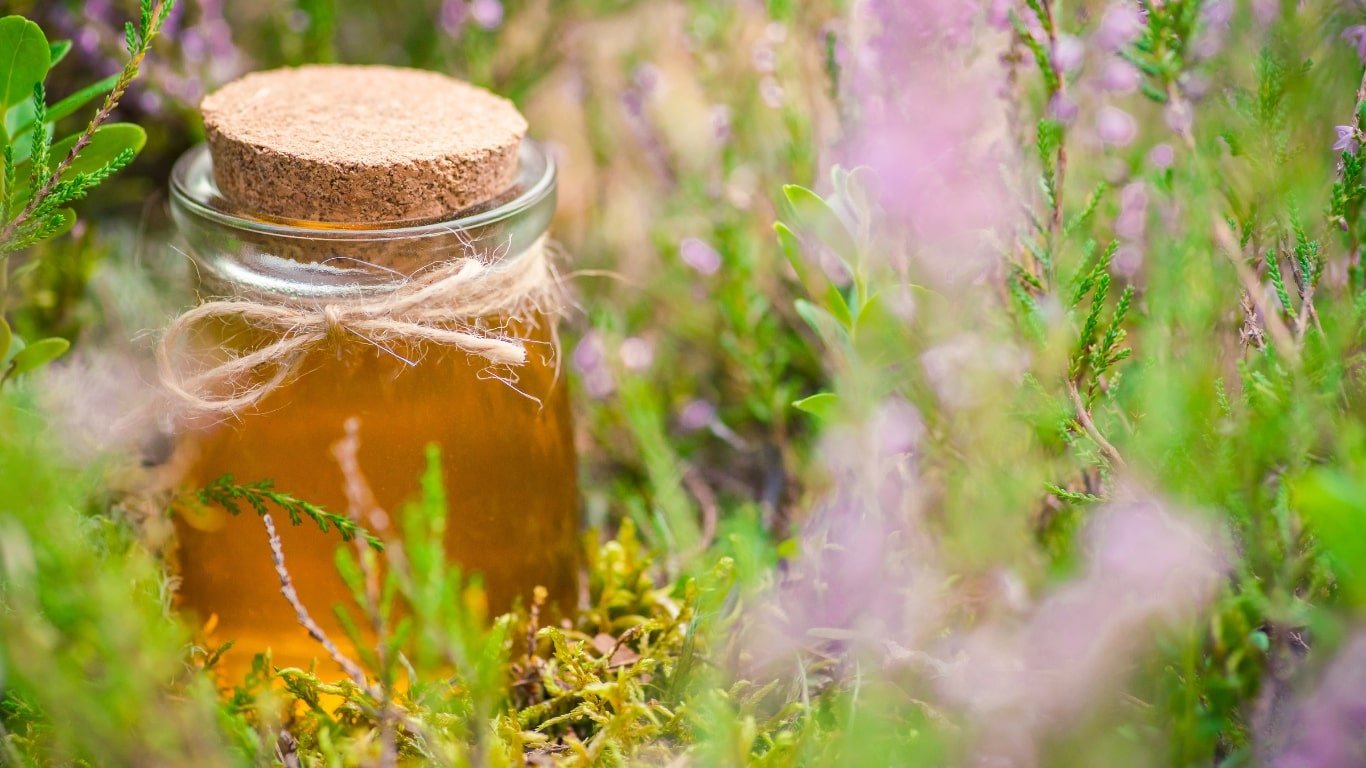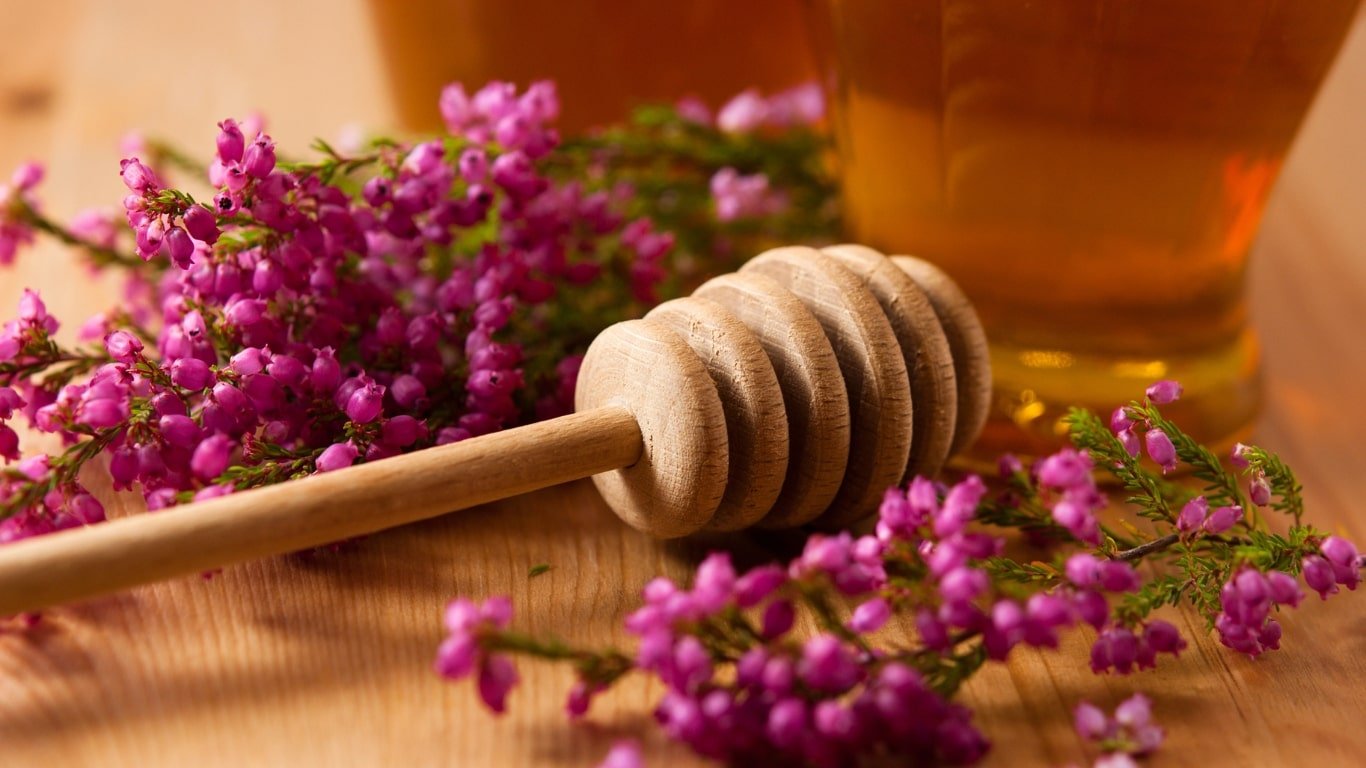
Introduction
Heather honey, often referred to as the “liquid gold of the moors,” is one of the most distinctive and prized types of honey in the world. Known for its unique flavor, rich nutritional content, and numerous health benefits, heather honey is a staple in both culinary and medicinal traditions, especially in regions where the heather plant thrives. This article delves deep into the origins, production process, characteristics, and benefits of heather honey, providing a comprehensive understanding of this exceptional natural product.
Origins and Production of Heather Honey
Heather honey is derived from the nectar of the heather plant, particularly the Ling heather (Calluna vulgaris) and the Bell heather (Erica cinerea), which are native to the moorlands, heathlands, and uplands of Europe. The plant is especially abundant in the British Isles, parts of Scandinavia, and some areas of Western Europe. Heather blooms between late July and early September, producing small, bell-shaped flowers that are rich in nectar. This brief flowering period is when bees, particularly the European honeybee (Apis mellifera), work tirelessly to collect the nectar and produce honey.
The process of producing heather honey is both intricate and time-consuming. Due to the viscous nature of the honey, beekeepers often use specialized equipment to extract it from the honeycomb. Traditional methods of extraction, such as pressing, are sometimes preferred because they retain the honey’s unique texture and preserve its natural qualities. The honey is then filtered to remove impurities, ensuring it is pure and ready for consumption.
Characteristics of Heather Honey
Heather honey is immediately recognizable by its distinctive appearance, texture, and taste. It is a dark amber color with reddish undertones, giving it a warm, inviting appearance. When stored, it may develop a jelly-like consistency, which is unique among honeys. This thixotropic property means that the honey can become more fluid when stirred, making it easier to spread or mix into foods and beverages.
The flavor of heather honey is robust, with a slightly bitter aftertaste that sets it apart from other types of honey. It has a complex, earthy, and aromatic profile, often described as smoky or woody, with hints of caramel and herbs. This makes it a favorite among honey connoisseurs and a valuable ingredient in gourmet cooking.
Heather Honey Nutritional Profile
Heather honey is not only celebrated for its taste but also for its nutritional content. Like other types of honey, it is primarily composed of sugars, including fructose and glucose, but it also contains a variety of vitamins, minerals, and antioxidants. Notably, heather honey is rich in phenolic compounds, which contribute to its strong antioxidant properties. These antioxidants help combat free radicals in the body, reducing oxidative stress and lowering the risk of chronic diseases such as heart disease and cancer.
Heather honey also contains amino acids, enzymes, and trace elements such as calcium, potassium, iron, and magnesium, which are essential for maintaining good health. The presence of these nutrients makes heather honey a valuable addition to a balanced diet, providing both energy and nourishment.
Health Benefits of Heather Honey

The health benefits of heather honey have been recognized for centuries, particularly in traditional medicine. Modern scientific research has also confirmed many of these benefits, making heather honey a popular natural remedy.
Antimicrobial Properties
Heather honey has been shown to have strong antimicrobial activity, making it effective in treating wounds, burns, and infections. Its high sugar content, low pH, and presence of hydrogen peroxide inhibit the growth of bacteria and fungi. Additionally, heather honey’s unique composition of phenolic compounds enhances its ability to fight off pathogens, making it an excellent natural alternative to synthetic antibiotics.
Anti-inflammatory Effects
The anti-inflammatory properties of heather honey are well-documented. It has been used to alleviate symptoms of inflammatory conditions such as arthritis, asthma, and digestive disorders. The antioxidants in heather honey reduce inflammation at the cellular level, helping to relieve pain and discomfort associated with these conditions.
Immune System Support
Regular consumption of heather honey can boost the immune system, thanks to its rich antioxidant content. By neutralizing free radicals and reducing oxidative stress, heather honey helps strengthen the body’s defenses against infections and diseases. It is also believed to have a positive effect on respiratory health, making it useful in treating colds, coughs, and sore throats.
Digestive Health
Heather honey has prebiotic properties, meaning it promotes the growth of beneficial bacteria in the gut. This supports healthy digestion and can help prevent digestive issues such as bloating, constipation, and irritable bowel syndrome (IBS). Its natural enzymes also aid in the breakdown of food, improving nutrient absorption and overall digestive function.
Skin Health
When applied topically, heather honey can improve skin health by moisturizing and nourishing the skin. Its antimicrobial and anti-inflammatory properties make it effective in treating acne, eczema, and other skin conditions. Heather honey can also help speed up the healing of wounds and reduce the appearance of scars, thanks to its ability to promote tissue regeneration.
Culinary Uses of Heather Honey
Heather honey’s bold flavor and rich texture make it a versatile ingredient in the kitchen. It can be used as a natural sweetener in a variety of dishes, from baked goods to sauces and marinades. Its strong taste pairs well with savory dishes, such as roasted meats and cheeses, adding depth and complexity to the flavors. Heather honey is also a popular addition to teas, herbal infusions, and even alcoholic beverages like mead and whiskey, where it enhances the drink’s natural flavors.
In addition to its use in cooking, heather honey is often enjoyed on its own, spread on bread or toast, or drizzled over yogurt and fruit. Its unique taste and health benefits make it a favorite among those who appreciate natural, wholesome foods.
Environmental Impact and Sustainability
The production of heather honey is closely tied to the health of the environment, particularly the heather moorlands where the plants grow. These habitats are home to a wide variety of flora and fauna, many of which are dependent on the heather for survival. The decline of these moorlands, due to factors such as climate change, agriculture, and urban development, poses a threat to both the heather plant and the honey production industry.
Efforts are being made to preserve and restore heather moorlands, recognizing their importance not only for biodiversity but also for the production of this valuable honey. Sustainable beekeeping practices are essential to ensure that honey production does not harm the environment and that the bees continue to thrive.
Frequently Asked Questions
What is special about heather honey?
Heather honey is special because of its unique characteristics, including a distinctively strong, earthy flavor with a slightly bitter aftertaste, and a jelly-like consistency that is rare among honeys. It is also rich in phenolic compounds, giving it potent antioxidant and anti-inflammatory properties, which contribute to its health benefits. Heather honey is sourced from the nectar of the heather plant, predominantly found in moorlands, adding to its uniqueness as a product closely tied to specific natural landscapes.
Why is heather honey so expensive?
Heather honey is expensive primarily due to the limited blooming period of the heather plant, which restricts the window for honey production. Additionally, the extraction process is more labor-intensive compared to other types of honey, requiring specialized equipment due to its thick, thixotropic nature. The scarcity of heather moorlands and the need for sustainable practices further contribute to the high cost, making it a premium product.
Is heather honey better than Manuka honey?
Whether heather honey is better than Manuka honey depends on the intended use and individual preference. Manuka honey is renowned for its potent antibacterial properties, particularly due to its high methylglyoxal (MGO) content, making it highly effective for medicinal uses, especially in wound care. On the other hand, heather honey offers a rich antioxidant profile and a unique flavor that appeals to gourmets and those seeking general health benefits. Both are exceptional in their own right, with different strengths depending on the application.
Conclusion
Heather honey is more than just a sweet treat; it is a testament to the intricate relationship between nature and humans. Its unique flavor, nutritional content, and health benefits have made it a prized commodity for centuries. As awareness of its qualities grows, so too does the appreciation for the environments in which it is produced and the need to protect them. Whether enjoyed as a gourmet ingredient, a natural remedy, or a simple indulgence, heather honey remains a true gift of nature, offering a taste of the wild, rugged landscapes from which it originates.



